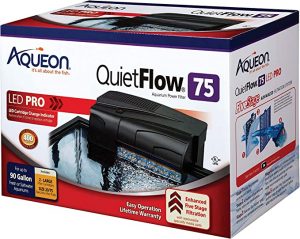Home>Furniture>Sand vs Gravel Aquarium Substrate: Which is Better?


Furniture
Sand vs Gravel Aquarium Substrate: Which is Better?
Modified: December 6, 2023
Aquarium substrate is an important fixture in most tanks. Conclude the sand vs gravel aquarium debate once and for all, with the help of this article!
(Many of the links in this article redirect to a specific reviewed product. Your purchase of these products through affiliate links helps to generate commission for Storables.com, at no extra cost. Learn more)
Aquarium substrate is a common fixture in most tanks. It refers to any loose material which coats the bottom of your tank. Substrate can take the form of pebbles, gravel, sand, aqua soil, clay, and more. While most underwater ecosystems can survive without it, aquarium substrate most definitely enhances your tank’s visual appeal. This article will not only compare two of the most popular substrate options but hopefully conclude the sand vs gravel aquarium debate once and for all.
Why is Aquarium Substrate Important?
Aquarium substrate is important as it serves a multitude of purposes. Besides boosting your tank’s overall aesthetic value, substrate helps alleviate the stress on your glass tank, and create a more natural environment for your fish to thrive. This is because it houses bacteria that is beneficial to the nitrogen cycle. This cycle refers to a process that promotes plant growth while reducing waste in the form of nitrites that are detrimental to your fish.
Most Common Substrates: Sand & Gravel
Despite the innumerable substrate options available on the market, the two most common are sand and gravel. While each of these serve the same core purpose, there are a few distinct features and key differences which make both substrate options more appealing than others. In the following sections, this article will draw comparison between sand vs gravel aquarium substrates in detail.
Benefits of Using Sand Substrate
A large number of aquarium owners consider sand the superior substrate over gravel. This is because sand appears more natural, is aesthetically pleasing, and is easier to clean. Furthermore, the majority of aquarium fish are naturally from (and thrive in) waters with sand substrate and a much lower flow. These fish tend to enjoy digging pits and sifting through the sand for food. As sand is much finer than gravel, the piles and slopes created whilst digging are not as steep as they would be with other substrates.
The ultra-fine nature of sand also prevents debris from falling in between gaps and causing bacterial build-up. This ensures that all toxic waste rests on top of the sandy surface, to be removed manually or picked up by the aquarium’s filters as the water flows. In other words, using a sand substrate will minimize the need for frequent in-depth cleaning.
Drawbacks of Using Sand Substrate
However, despite its innumerable benefits, sand can prove to be detrimental to your ecosystem if not incorporated correctly. After all, not all sand can be used in an aquarium. Researching the quality and type of sand you intend to use is extremely essential. Avoid skimping on your substrate by using cheaper alternatives such as pool sand, or pool filter sand. Sand that is not designed for use in aquariums can create pockets of anoxic bacteria and eventually emit toxic hydrogen sulfide gas – a result which can be fatal to your fish.
Another drawback of using poor quality or non-aquarium-safe sand is the increased risk of a brown algae outbreak. While a small dose of brown algae may not be detrimental to the health of your fish, the presence of these Phaeophyceae, may not prove beneficial to your overall underwater ecosystem. When not managed properly, these seaweed-like additions will compete for nutrients, block out sunlight, and potentially kill both your plants and fish. Therefore, it is best to avoid low-quality sand, as they are silica-based, and can destabilize your tank’s entire ecosystem.
Pros and Cons Summary: Sand Substrate
Pros
- Prevents bacterial build-up
- Easier to clean
- Low maintainence
- Allows fish to dig pits
Cons
- May increase risk of a brown algae outbreak
- Can cause anoxic bacteria
- Might emit toxic hydrogen sulfide gas
Benefits of Using Gravel Substrate
The sand vs gravel aquarium substrate debate isn’t so easily resolved. Even though sand does have a number of convincing advantages, the case for gravel substrate remains just as compelling. After all, gravel substrate is best used in freshwater aquariums. This is because, it allows water to flow uninhibited, thus preventing the buildup of amoebas, bacteria, and mold.
Furthermore, due to gravel’s heavier nature, it is less likely to be swept into aquarium filters or consumed by your fish. This is unlike sand, which can be easily picked up along with food, or spat into the filter by your fish. By staying far away from your filter, gravel substrate ensures that your aquarium’s essential equipment continues to work safely and efficiently, even without additional maintenance.
Gravel is also a great substrate option for aquariums with plants. This is because, plants can easily anchor themselves in between the gravel to create more stable roots. As gravel is an inert substrate, it will also not influence the water parameters of your tank.
Drawbacks of Using Gravel Substrate
Despite gravel’s larger size than most other substrates, fish may still try to consume or nibble at it. Your substrate may then turn into a choking hazard in the long run as the gravel eventually breaks down or chips into smaller pieces.
Furthermore, due to its sheer size, and innumerable gaps, food may easily be trapped in between this substrate, causing a build-up of bacteria within your tank. This will affect water quality and may cause you to conduct water changes more frequently.
Incorporating gravel into an aquarium with bottom-feeders or fish that enjoy digging or sifting through substrate, can also result in an increased amount of fish injuries, infections, or mortality rate.
Pros and Cons Summary: Gravel Substrate
Pros
- Available in multiple colors
- Will not influence water parameters
- Provides an anchor for plants
- Allows water to flow uninhibited
- Safe for aquarium filters
Cons
- May trap food
- Can be a choking hazard
- Requires frequent water changes
How To Clean Sand vs Gravel Aquarium Substrate
One essential factor to consider when deciding between sand vs gravel aquarium substrate is maintainence. How suitable and effective a substrate is in your tank, is often guaged by how much maintainence it requires to fulfill its basic functions. While both sand and gravel have their own unique set of pros and cons, both require the same form of periodical cleaning. Listed below are some simple yet effective ways to clean both substrates.
Sand sifters
Sand sifters refer to specific fish species which are known and used to clean a variety of aquarium substrates. These species include the Corydoras catfish, Tiger Watchman Goby, and Diamond Watchman Goby, among many others. Incorporating these natural sand sifters into your aquarium can help keep it cleaner for longer, as they are often found gulping mouthfuls of sand and raking through it for tiny morsels of food. This allows them to inadvertantly release trapped food particles from deep within your substrate, and disrupt the growth of bacteria on your tank’s sand or gravel surface.
To lend your sifters a hand or speed up the cleaning process, you may consider running your fingers through the sand bed regularly. This process will help seive through the surface, turning it over and dislodging dirt and debris.
Bonus Tip: Combine this method with a mechanical filter and water change to completely eliminate most dirt and debris
Gravel/Power vacuum
A gravel vacuum is a simple device designed to suck up dirt and debris without hassle. In its simplest form, this device comprises a flexible syphon tube, a clear pipe, and a suction pump. Despite its name, gravel vacuums can be used to clean sand substrate as well. Just take note that gravel is easier to vacuum than sand as it is heavier and less likely to be sucked through the pipe.
When cleaning sand substrate with a gravel vacuum, simply hover the pipe over your sand substrate and add pressure to the suction pump in small and quick intervals. Though this is a slower process, it will allow you to suck up dirt and harmful debris, without significantly reducing the amount of substrate in your tank.
Sand vs Gravel Aquarium Substrate: Final Verdict
| Sand | Gravel | |
|---|---|---|
| Maintenance | Easy to clean. Dirt, debris, and bacteria are concentrated on the substrate’s surface. | Requires frequent water change and cleaning |
| Potential Risks | Low-quality sand can create pockets of anoxic bacteria. May emit fatal hydrogen sulfide gas. | Traps food easily, can cause build-up of bacteria. |
| Benefits | Prevents bacterial build-up, low maintenance, allows fish to dig pits. | Will not influence water parameters, provides an anchor for plants, allows water to flow uninhibited, safe for aquarium filters. |
So after much comparison, you’re probably still wondering what the sand vs gravel aquarium substrate conclusion is. Well, that conclusion entirely depends on the sort of aquarium ecosystem you are building, and how often you intend to maintain it. Sand substrate is best used for saltwater aquariums that house several bottom feeders and sand sifters. On the other hand, gravel substrate is most suitable for freshwater aquariums where a constant flow of water beneath the surface is essential to maintaining plant and fish health.
If you enjoyed this article, consider further enhancing your tank’s visual appeal and ecosystem with the help of these LED aquarium lights.
Was this page helpful?
At Storables.com, we guarantee accurate and reliable information. Our content, validated by Expert Board Contributors, is crafted following stringent Editorial Policies. We're committed to providing you with well-researched, expert-backed insights for all your informational needs.


























0 thoughts on “Sand vs Gravel Aquarium Substrate: Which is Better?”